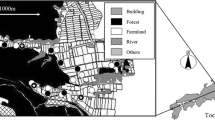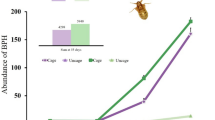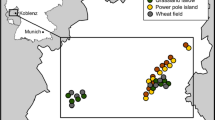Abstract
Two rice bug species, Stenotus rubrovittatus (Matsumura) and Trigonotylus caelestialium (Kirkaldy) (Hemiptera: Miridae), are major rice pests in Japan. The populations of these insects are maintained by widely distributed host plants and by a broad range of movements among resource patches. To develop an effective pest management strategy for a region where two rice bug species coexist, the impacts of the surrounding landscape and of weed-infested field boundaries on the field abundances of the two rice bug species were compared. Field abundances of the two species were estimated using the sweep-netting technique. The number of weed-infested field boundaries was also counted within a 100 m radius around 14 study paddies at three sites in Japan. The distinctive features of the surrounding landscape furnished the best predictor at a spatial scale radius of 300 m for S. rubrovittatus and at 200–300 m for T. caelestialium. The abundances of both species increased as the amounts of weed-infested area and reclaimed land increased. The size and number of sources also affected the two rice bug species. These results emphasize that adequate field boundary management can reduce the risk of high pest abundance in the fields, even when an extensive weed-infested area exists within the functional scale of the species.




Similar content being viewed by others
References
Batáry P, Báldi A, Samu F, Szűts T, Erdős S (2008) Are spiders reacting to local or landscape scale effects in Hungarian pastures? Biol Conserv 141:2062–2070
Bianchi FJJ, Booij CJH, Tscharntke T (2006) Sustainable pest regulation in agricultural landscapes: a review on landscape composition, biodiversity and natural pest control. Proc Roy Soc B 273:1715–1727
Carrière Y, Ellsworth PC, Dutilleul P, Ellers KC, Barkley V, Antilla L (2006) A GIS-based approach for areawide pest management: the scale of Lygus hesperus movements to cotton from alfalfa, weeds, and cotton. Entomol Exp Appl 118:203–210
Clough Y, Kruess A, Tscharntke T (2007) Local and landscape factors in differently managed arable fields affect the insect herbivore community of a non-crop plant species. J Appl Ecol 44:22–28
Deguine J-P, Ferron P, Russell D (2008) Sustainable pest management for cotton production. A review. Agron Sustain Dev 28:113–137
Downie IS, Ribera I, McCracken DI, Wilson WL, Foster GN, Waterhouse A, Abernethy VJ, Murphy KJ (2000) Modelling populations of Erigone atra and E. dentipalpis (Araneae: Linyphiidae) across and agricultural gradient in Scotland. Agric Ecosyst Environ 80:15–28
Duelli P (1990) Population movements of arthropods between natural and cultivated areas. Biol Conserv 54:193–207
ESRI (2004) ArcGIS version 9.2. Environmental Systems Research Institute, Redlands
Goto J, Higuchi H (2004) Preliminary evaluation of the flight ability of the rice leaf bug, Trigonotylus caelestialium (Kirkaldy) (Heteroptera; Miridae), investigated by tethered flight technique. Jpn J Appl Entomol Zool 48:219–224 (in Japanese with English abstract)
Hachiya K (1999) Migration of rice leaf bug, Trigonotylus caelestialium (Kirkaldy) into rice fields and forecasting of the abundance. Plant Prot 53:268–272 (in Japanese)
Hayashi H (1986) Ecology and control of the sorghum plant bug (Stenotus rubrovittatus Matsumura) causing the pecky rice. Plant Prot 40:321–326 (in Japanese)
Hayashi H (1997) Historical changes and control of rice sting bug complex causing the pecky rice. Plant Prot 51:455–461 (in Japanese)
Hendrickx F, Maelfait J-P, van Wingerden W, Schweiger O, Speelmans M, Aviron S, Augenstein I, Billeter R, Bailey D, Bukacek R, Burel F, Diekötter T, Dirksen J, Herzog F, Liira J, Roubalova M, Vandomme V, Bugter R (2007) How landscape structure, land-use intensity and habitat diversity affect components of total arthropod diversity in agricultural landscapes. J Appl Ecol 44:340–351
Higuchi H (2006) Seasonal changes in egg parasitism of the rice leaf bug, Trigonotylus caelestialium (Kirkaldy) (Heteroptera: Miridae) in Italian rye-grass fields. J Appl Entomol Zool 50:167–169 (in Japanese with English abstract)
Hunter MD (2002) Landscape structure, habitat fragmentation, and the ecology of insects. Agric Forest Entomol 4:159–166
Ichimori T, Chiba T, Tanaka H, Ito M (1990) Relation between the content of spotted rice and the distance from the origin place of sorghum plant bug, Stenotus rubrovittatus Matsumura. Ann Rep Plant Prot North Japan 41:121–124 (in Japanese)
Ishimoto M (2008) Development of sorghum plant bug, Stenotus rubrovittatus (matsumura) (Heteroptera: Miridae) nymphs reared on hulled rice. Jpn J Appl Entomol Zool 52:139–141 (in Japanese with English abstract)
Ito K (2004) A possible cause of recent outbreaks of rice-ear bugs-changing in the use of paddy field. Ann Rep Plant Prot North Japan 55:134–139 (in Japanese)
Kashin J, Hatanaka N, Ono T, Oyama J, Kidokoro T (2009) Effects of Scirpus juncoides Roxb. Var. ohwianus on occurrence of sorghum plant bug, Stenotus rubrovittatus (Matsumura) (Hemiptera: Miridae) and pecky rice. Jpn J Appl Entomol Zool 53:7–12 (in Japanese with English abstract)
Katase M, Shimizu K, Shina S, Hagiwara K, Iwai H (2007) Seasonal occurrence of rice bugs in the Northern part of Chiba Prefecture. Ann Rep Kanto-Tosan Plant Prot Soc 54:99–104 (in Japanese)
Kikuchi A, Kobayashi T (2004) Growth and oviposition of the rice leaf bug, Trigonotylus caelestialium (Kirkaldy) (Heteroptera: Miridae), on gramineous weeds and Italian rye grass. Ann Rep Plant Prot North Japan 55:149–154 (in Japanese)
Kikuchi A, Kobayashi T (2005) Weeding of paddy field ridge and farm road as a measure against stink bugs causing spotted rice. Agric Hortic 80:15–22 (in Japanese)
Kikuchi A, Ishioka M, Kobayashi T (2004) Effect of some factors on flight activity on Trigonotylus caelestialium (Kirkaldy) (Heteroptera: Miridae). Ann Rep Plant Prot North Japan 55:140–142 (in Japanese)
Ono T, Kashin J, Kidokoro T (2007) Control of sorghum plant bug, Stenotus rubrovittatus (Matsumura) (Hemiptera: Miridae), in rice paddy field by grass mowing in relation to migration source. Ann Rep Plant Prot North Japan 58:75–79 (in Japanese)
Ono T, Kashin J, Kidokoro T, Sato K, Ishihara N (2010) Control of Sorghum plant bug, Stenotus rubrovittatus (Matsumura) (Hemiptera: Miridae) in rice paddy field by grass mowing in migration source and application of new insecticides. Bull Miyagi Pref Furukawa Agric Exp Station 8:35–45 (in Japanese with English summary)
Pluess T, Opatovsky I, Gavish-Regev E, Lubin Y, Schmidt-Entling M (2010) Non-crop habitats in the landscape enhance spider diversity in wheat fields of a desert agroecosystem. Agric Ecosyst Environ 137:68–74
R Development Core Team (2005) R: a language and environment for statistical computing. R Foundation, Vienna. http://www.R-project.org
Takada M (2010) Evaluation of function of the predaceous enemy to rice pest species. In: Washitani I, Miyashita T, Nishihiro J, Kadoya T (eds) Methods in conservation ecology. Tokyo University Press, Tokyo, pp 217–237
Takahashi A (2008) Studies on the life history and ecological characteristics of the rice leaf bug, Trigonotylus caelestialium (Kirkaldy) (Heteroptera: Miridae) (unpublished doctoral dissertation). Tohoku University, Sendai
Takeda A, Shimizu K, Shiina S, Hagiwara K, Katase M (2008) Seasonal prevalence of Stenotus rubrovittatus (Hemiptera: Miridae) in gramineous weed field and a rice field. Ann Rep Kanto-Tosan Plant Prot Soc 55:97–102 (in Japanese)
Takita M (2007) Influence of weeding in the ridge on the premise that basics chemical control of Yamagata prefecture and control effect of new systematic insecticide, for Trigonotylus caelestialium (Kirkaldy). Iss Yamagata Pref Agric Res 39:55–67 (in Japanese)
Tanaka H, Ichimori T, Chiba T (1991) Evaluation of partial spraying in the field for the control of pecky rice caused by stink bugs. Ann Rep Plant Prot North Japan 42:103–105 (in Japanese)
Teramoto N (2003) Control of rice sting bug complex (Hemiptera) in paddy fields by gramineous weed control on balks. Bull Shiga Pref Agric Res Exp Station 43:47–70 (in Japanese with English summary)
Tscharntke T, Klein AM, Kruess A, Steffan-D I, Thies C (2005) Landscape perspectives on agricultural intensification and biodiversity—ecosystem service management. Ecol Lett 8:857–874
Watanabe T, Higuchi H (2006) Recent occurrence and problem of rice bugs. Plant Prot 60:201–203 (in Japanese)
Yamagishi K (2004) Generic composition of Scelionidae (Hymenoptera) in agricultural lands. Jpn J Entomol (N.S.) 7:39–54 (in Japanese with English abstract)
Yuasa K, Tanaka Y, Kakuda I (2003) A distribution pattern of pecky rice incidence in a single paddy field lot in Shiga Prefecture. Bull Shiga Agric Res Cent Exp Stn 43:71–88 (in Japanese)
Zaller JG, Moser D, Drapela T, Schmöger C, Frank T (2008) Effects of within-field and landscape factors on insect damage in winter oilseed rape. Agric Ecosyst Environ 123:233–238
Acknowledgments
We are grateful to the farmers for providing us with permission to work on their land. Additionally, we thank the staff at Chiba, Katori Agriculture and Forestry Promotion Center for their help. This study was partly supported by a Grant-in-Aid for Research Projects Utilising Advanced Technologies in Agriculture, Forestry and Fisheries from the Ministry of Agriculture, Forestry and Fisheries, Japan.
Author information
Authors and Affiliations
Corresponding author
Rights and permissions
About this article
Cite this article
Yasuda, M., Mitsunaga, T., Takeda, A. et al. Comparison of the effects of landscape composition on two mirid species in Japanese rice paddies. Appl Entomol Zool 46, 519–525 (2011). https://doi.org/10.1007/s13355-011-0071-9
Received:
Accepted:
Published:
Issue Date:
DOI: https://doi.org/10.1007/s13355-011-0071-9




